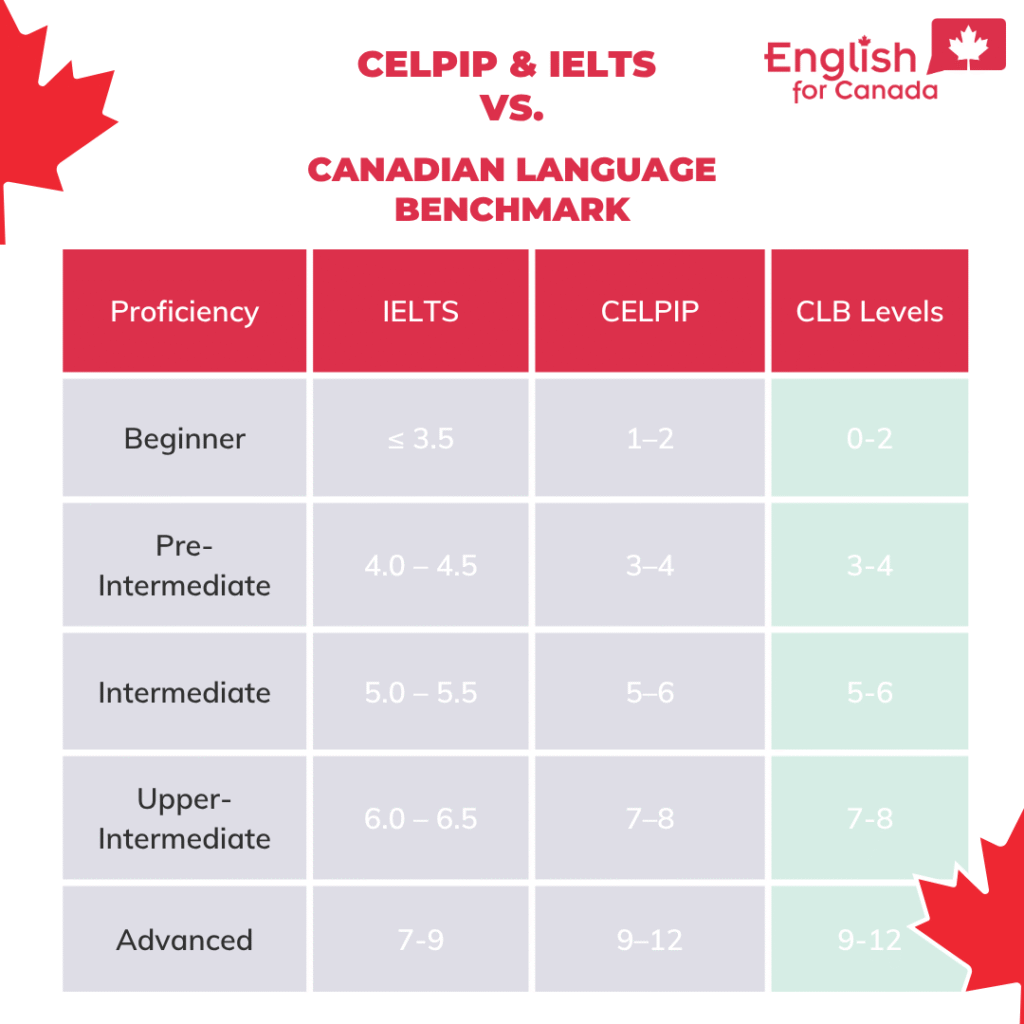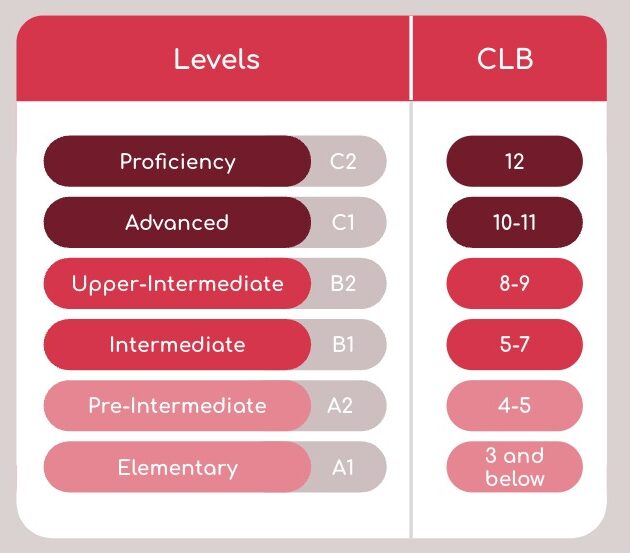What’s the difference between the IELTS and CELPIP tests?
Which test is easier, the IELTS or the CELPIP?
I’ve heard the CELPIP test is easier than the IELTS. Is that true?
I get these questions every. single. day. And in this straight forward guide, I’m sharing everything I’ve learned over 12 years of teaching and testing, along with my honest and expert opinion.
So if you haven’t met me yet, I’d love to introduce myself 🇨🇦
Hi! 👋 I’m Maria and I’m a Level 3 certified Canadian CELPIP Expert and an IELTS examiner. I’m also the founder and CEO of English for Canada, an Official Member of the CELPIP Network.
Our team has helped thousands of students just like you reach their goals and we’re grateful for 240+ 5-star Google reviews ⭐️⭐️⭐️⭐️⭐️
My goal here is to help you confidently choose the right test and path for you.
I am honoured to say that Prometric Testing (CELPIP Canada) has approved my school English for Canada as an official CELPIP exam preparation school and as a trusted resource for those seeking to apply for their Canadian Permanent Residency through the Comprehensive Ranking System (CRS).
I respect both test providers and you’ll find my views are based solely on my observations from student and test taker results – not biased or playing favourites. ☝️
Over the years, I’ve coached thousands of students from around the world on how to get the band scores they need on their IELTS or CELPIP tests with proven results.
I’m on your side, so let’s get started!
Now let’s be honest. The IELTS and CELPIP exams are challenging. But the good news is – getting the band scores of your dreams is not impossible.
You can immigrate to Canada. It is possible. Our students are proof!
But the reality is that both tests require study prep, dedication, mental stamina, and a realistic study plan according to your proficiency level and objective.
It’s important to realize that while there are definitely test strategies you can and must learn, you will still have to improve your overall English proficiency level to get the results you’re looking for.
There are simply no shortcuts when it comes to learning a language. Learning a new language takes time.
The Canadian Language Benchmark
If you need to take the IELTS General Training test or the CELPIP test, you need to achieve a specific CLB (Canadian Language Benchmark). In other words, you need to prove a specific English proficiency level for your immigration process.
The final result on your IELTS or CELPIP test will be converted into a CLB level based on what you scored on each exam section. The final CLB rating is different between the IELTS and the CELPIP test so first find out exactly which band scores you need.
If you need a CLB 9, take note that the CELPIP test considers your lowest band score as your final CLB.
In theory, the CLB does not change from one test to another. That’s because the CLB levels are standardized and you are rated on a scale. In other words, the CLB 7, 8, or 9 are rated the same way on both tests.
That’s why saying one test is “easier” than the other isn’t really possible.
Check out this handy table below comparing both tests, the CLB, and your expected English proficiency level.
The real reason why you might find one test easier than the other is due to a major difference between test formats, and this can make a big difference in your final results.
So before paying around $300 for your next test, consider these factors:
-
- Which CLB do you need?
-
- The band scores you need will impact your decision. If you need a CLB 7 or 8, both exams will work just fine, but a CLB 9 is a high band score (equivalent to C1 advanced proficiency level) and will definitely require a proper or longer exam prep.
-
- Which CLB do you need?
-
- What is your current proficiency level?
-
- The bigger the gap between your current proficiency level and your final objective, the longer you will take to prepare. Remember that improving your English can also take time.
-
- What is your current proficiency level?
-
- How much time do you realistically have to study?
-
- What’s your daily schedule like? Are you really ready to invest some time studying?
-
- How much time do you realistically have to study?
-
- How do you cope with test anxiety?
-
- Most candidates struggle with test anxiety at some point, so it’s important to come up with a game plan so that you take your test confidently.
-
- How do you cope with test anxiety?
So, with that out of the way, should you take the IELTS or the CELPIP?
Let’s break down both of these tests according to each exam section, shall we?
The CELPIP Listening Test vs. the IELTS Listening Test
If you need a CLB 9+ for your immigration profile, then you’ve realized how challenging the listening tests for the IELTS and the CELPIP can be.
Getting that pesky Band 8 on the IELTS listening test is definitely not easy! This is exactly why many candidates migrate over to the CELPIP.
Does it sound like I’m talking directly at you? 😉
Here are some helpful differences between the two listening tests so that you can decide which test is better for you:
Duration: The CELPIP listening test is longer (almost 1 hour) while the IELTS listening test is about 30 minutes. If you find it difficult to pay attention to an audio passage for a long period of time, this may be worth considering.
Format: The CELPIP test has 6 parts and the IELTS has 4 sections. Due to test development, the CELPIP test might also include 1-2 additional unscored bonus sections.
Navigation: On the CELPIP test, you can’t go back and review or change your answers once you’ve moved on to the next section, while you can on the IELTS.
Style: Both can be done on the computer now, but the IELTS also has the paper-based version available. In general, most candidates prefer the computer-delivered IELTS and I encourage avoiding the paper-based IELTS listening test as not every IELTS exam centre offers headsets just yet (most do, at least in Canada).
Equipment: If you do choose the IELTS, make sure you choose an exam centre with a headset so that you can properly hear your test. The CELPIP test will always include a headset.
Approach: On the CELPIP test, you only get to read the questions after you’ve listened to the audio passage. This means that note-taking and memorization is super important. On the IELTS, you have 1 minute to read and analyze your questions before you listen, and this helps you prepare yourself for what’s coming. Check out our tips on how to take notes on your CELPIP listening test and our UBER strategy for the IELTS listening test!
Question Types: The CELPIP has 3 different question types while the IELTS has 6.
Multiple Choice: The CELPIP always includes a drop-down menu whereas the IELTS has fill-in-the-blank style answers. This means you can always guess your answers on the CELPIP – a huge plus.
Spelling: Since the CELPIP only has a drop-down menu with options, you won’t have to worry about spelling. On the other hand, the IELTS test takes spelling into consideration. This is a major reason why many candidates get answers wrong.
Accents: The CELPIP test only includes Canadian accents. The IELTS test includes speakers with a variety of accents (British, American, Australian). Many test takers prefer the CELPIP due to this; however, I argue that it’s important to learn how to understand a variety of accents for real-life communication.
Video: The CELPIP listening test even includes a video. The IELTS does not. Sometimes the video can be a challenge because you have to focus on what the speakers are wearing, their body language, and their facial expressions, so pay attention 👀.
✅ My Verdict: Even though the CELPIP test only uses Canadian accents, I still prefer the IELTS because I like having the option of reading the questions before listening.
At the end of the day, I encourage trying some of the free sample tests available on the official CELPIP website or on an official IELTS website (definitely do not study off of Youtube or someone’s random website or channel, please).
Make sure you’re studying from authentic and qualified test preparation material that includes official paid practice tests like my Prometric-testing approved CELPIP self-study course.
That way you can get a feel for which exam format you prefer. Also, while we’re on the topic of listening, check out our other blog post on the pros and cons of the CELPIP listening test.
The IELTS Reading Test vs. The CELPIP Reading Test
Both reading tests are very similar in terms of difficulty. Remember, the English itself within the reading passages is the same on both tests.
You are being assessed on your comprehension, but as you probably already know, getting the band score you need on your reading test also means learning exam test strategies.
Here are some differences between the two reading exams:
Duration: Both tests last about 1-hour long, and they both get progressively more difficult. In other words, each reading section gets more challenging than the one before.
Format: The CELPIP has 4 sections and the IELTS has 3. Note that the CELPIP also includes 1-2 additional practice tasks for test development which can tire you out. In other words, instead of having 4 sections, your test might actually have 5-6. However, only 4 count towards your actual test.
Navigation: On the CELPIP test, you can’t go back and review or change your answers once you’ve moved on to the next section, while you can on the IELTS.
Number of Questions: Both have about 40 questions.
Style: Both can be done on the computer, but the IELTS also has the paper-based version available. In general, most candidates prefer the computer-delivered IELTS over the paper based.
Approach: Both tests require specific exam strategies. Check out our personalized lessons for the IELTS or the CELPIP if you need help passing your test.
Question Types: The CELPIP has 3 different question types while the IELTS has over 10.
Multiple Choice: The CELPIP always includes a drop-down menu whereas the IELTS has fill-in-the-blank style answers. This means you can always guess the answer on the CELPIP.
Spelling: Since the CELPIP only has a drop-down menu with options to fill in the sentences, you won’t have to worry about spelling. 😀 On the other hand, the IELTS test takes spelling into consideration. However, you should be inputting content from the reading passage so as long as you’re being careful, this shouldn’t be an issue.
Instructions: Sometimes the instructions on the IELTS can be tricky like “no more than one word”, and students can easily get questions wrong simply because they didn’t follow the instructions. In general, this doesn’t happen on the CELPIP.
Topics: The CELPIP test only includes Canadian topics about everyday life whereas the IELTS may include more international topics. Arguably, the CELPIP test includes more functional, everyday language; however, Task 4 of the CELPIP reading test isn’t easy as it includes lots of challenging vocabulary.
Vocabulary: Since the CELPIP test is Canadian, you’ll only see Canadian vocabulary on the reading test. This is very helpful for test takers who live in Canada and are used to hearing and reading Canadian vocabulary.
✅ My Verdict: Both tests are equally challenging. I would personally get concerned about getting extra test sections on the CELPIP test, but that doesn’t always happen. I suggest trying out a couple of practice tests to see which one you prefer.
Which Writing Test is Easier?
The IELTS or the CELPIP?
The IELTS or the CELPIP?
The Writing test is arguably one of the most challenging sections of the exam.
Why?
Because your final band score is determined by the IELTS or CELPIP performance standards (how you’re assessed by an examiner).
This means you need to improve your English proficiency and learn test strategies.
Recently in 2025, Prometric Testing (the test provider for the CELPIP test) announced that they would be switching their method of assessment for the writing test to an “AI Hybrid model”, meaning AI will first assess your writing test and then a CELPIP examiner will double check it.
Do I agree with this and think this will work?
As a professional who has worked as an examiner for numerous English proficiency tests, I am not convinced yet. At this point, I don’t have enough information about how their AI is being trained, but I simply cannot imagine humans being completely replaced when it comes to assessing language.
I, personally, have fed examiner assessed IELTS writing tests into ChatGBT and have compared what AI has come up with, and AI has consistently underscored candidates.
As of now, IELTS has not announced that they will be switching to any AI assessment methods like the CELPIP or even the PTE have.
Aside from how you are assessed, let’s move on to test formats.
There are major differences between the format of these two tests, and even a native speaker would need to prepare for their test. Find out why most students don’t pass.
How are the IELTS writing tests and the CELPIP writing tests different?
In terms of the exam formats, Writing Task 1 is the same on both the IELTS and the CELPIP test.
You’ll have to write a 150-word email/letter with the same instructions and expectations, but for time management, on the CELPIP you’ll have about 5 more minutes to complete the task.
On the CELPIP test, you’ll have about 25 minutes to write your letter, and on the IELTS, you should plan/aim to complete it within 20 minutes.
As for Writing Task 2, the IELTS requires you to write a complete academic-style essay, and the CELPIP asks you to complete a survey response.
The CELPIP survey response does not need to follow an academic-style format; however, formatting your writing is still a must. To learn how in 5 easy steps, get in touch with our team or check out our CELPIP Writing Course for sample responses.
Word count: The IELTS test has a minimum word count of 250 words for Task 2 and 150 for Task 1, however, don’t worry about counting your words. You’ll only stress yourself out and the examiners don’t have time to count your words either. They are focused on assessing your English. Not counting your words. The CELPIP test has a minimum word count of 150-200 for both tasks. Keep in mind that even though the CELPIP requires less words, you have less time to write your response. Also, I find that having less words to play with actually makes it harder to fully develop your ideas. Be careful: you can be penalized on the CELPIP test if you write too many words.
Question Types: For Writing Task 2, the IELTS test has several different question types that you must be prepared for. We teach the differences between them in class in our one-on-one tutoring sessions. The CELPIP, on the other hand, only has one Task 2 question type (the survey). To learn more about Task 2 on the CELPIP test, check out our CELPIP Writing Course.
Style: IELTS responses are expected to be more structured/academic whereas the CELPIP is a bit more flexible. However, in both cases, you must meet all the assessment criteria. You can count on our team to teach you how to write a CLB 9+ response in our private coaching sessions.
Topics: Since the CELPIP test is a Canadian-based test, the topics on the Writing test are based on daily life in Canada. The IELTS is an international English exam, so the topics on the exam are international and can be a bit more challenging (think global issues like gender roles, the environment, taxes). Either way, you’ll be able to think of ideas for both tests as they are about real-life issues.
Time Management: The CELPIP exam gives you approximately 25 minutes to complete each writing task. On the IELTS, you will be given 60 minutes and you have to manage your time. Students actually prefer the IELTS here as they can decide how much time they spend on each task.
Computerized: The CELPIP test is always done on the computer, and the IELTS has both the computer-delivered and paper-based version of the test.
Spellcheck: This a huge one! The CELPIP test has spellcheck, but the IELTS doesn’t. Keep in mind that similarly-spelled words like “quit” and quiet” will not be recognized by spellcheck, so meaning and accuracy are still important.
Assessment: The CELPIP Test is more subjective than the IELTS as the quality of your ideas is taken into consideration.
Preparation Time: In general, the IELTS tests requires more preparation time since you’ll need to learn how to write a solid academic-style essay. You’ll also need to fully learn the differences between the different IELTS question types.
✅ My Verdict: The CELPIP test is a great option if you prefer simple, everyday topics and if you prefer a shorter exam preparation. The IELTS test is more structured, standarized, and will require critical thinking about world issues. I prefer the IELTS, but have helped hundreds of students successfully achieve their goals on both tests. It is a personal preference.
Most importantly, both tests require understanding how you’ll be assessed and receiving personalized feedback and corrections to succeed.
After years of teaching and examining experience, I have developed a step-by-step formula to help you understand exactly what your examiner will be expecting from you without you spending thousands of dollars on multiple tests or your exam preparation.
Your success is our success and we want you to take your next test confidently.
Check out our private IELTS tutoring sessions.
Check out our private CELPIP tutoring sessions.
Check out our CELPIP Writing Course.
The IELTS Speaking Test vs. The CELPIP Speaking Test
There is one major difference between the IELTS and CELPIP exam, and that is…the speaking test 🎙️
This exam section alone could be your deciding factor as to which exam you choose to take.
So let’s get into the differences.
Format: The CELPIP exam is held on a computer with 8 timed tasks. The IELTS exam is held in person with an IELTS Speaking examiner.
Privacy & Exam Environment: The CELPIP exam is held in a room with several other candidates typing or speaking at the same time, which can be distracting. Due to the exam environment, you’re not allowed to speak too loudly. The IELTS exam is in a quiet and private room between you and your speaking examiner. While yelling is obviously not encouraged, you don’t have to worry about your volume.
Timer: You don’t need to worry about the timer on the IELTS exam as your examiner will monitor the time for you. However, on the CELPIP, you’ll need to study with a timer since you’ll be strictly timed throughout your entire speaking test. Learn how to beat the timer.
Topics: The IELTS topics are about everyday life and about you. This makes it easier to think of ideas. The 8 questions on the CELPIP test vary from describing pictures to putting yourself in situations (you have to think on the spot and be creative). If you need help preparing for your test, check out our CELPIP tutoring for feedback and our CELPIP speaking course for sample responses.
Duration: The IELTS Speaking test ranges from 11-14 minutes. The CELPIP speaking test is about 15-20 minutes long. The IELTS Speaking test happens either before or after the other 3 sections of your exam (there’s a break between these exam sections). Some students prefer taking the test all in one go (CELPIP), while some prefer having a break in between the test sections (IELTS).
Overall, most of our students would agree that the IELTS speaking test is a much more comfortable test to take than the CELPIP speaking test, and as a result, they do better on their test.
✅ My Verdict: At the end of the day, I personally find the IELTS Speaking test to be much more natural.
Why? You speak with a human. You get to have a natural conversation about you, your life and your opinions. You don’t have to be as creative, think of ideas on the spot and you don’t have to manage a timer.
Many students have expressed that they get very nervous speaking in front of an examiner or in a room with other test takers. If you’re like the thousands of students who’ve got test anxiety, know that you’re not alone! You can overcome your test anxiety.
And if you feel nervous about speaking with an IELTS examiner, keep in mind that they aren’t scary. They want you to succeed, and they’ll always ask you questions so that you keep speaking. If they interrupt you, that doesn’t mean you’ve done anything wrong, it just means they need to keep going to stay on time ⏱️
While speaking with an examiner might seem scary at first, since they’re there to help guide your conversation, you’ll see just how much more comfortable you feel on your test day.
If you still prefer the CELPIP speaking test, that’s great too! Lots of our students have achieved their goals on the CELPIP test too. Just make sure you practice with a timer for all 8 speaking tasks. 👍
Just like anything, the more you practice, the more confident you’ll feel. Check out our CELPIP Speaking Course to hear over 54 sample responses and to gain access to our Speaking Test Toolkits.
Final Recommendation: Which Test Should You Choose?
If you’re still feeling torn, here’s what I suggest:
🎧 Step 1: Try Both Listening Tests
- For a CLB 9+, the IELTS requires 35 out of 40 —very high, but definitely doable with practice.
- Take sample tests for both.
- Ask: Which test allows you to score CLB 9 more consistently?
- Can you understand multiple accents (IELTS) or do you prefer the Canadian accent (CELPIP)?
For Free CELPIP sample tests: Try them here
For Free IELTS sample tests: Try them here.
🎙️ Step 2: Evaluate the Speaking Format
- If test anxiety is a concern, IELTS’s one-on-one format is gentler.
- If you’re okay with managing a timer, thinking outside of the box, and speaking into a mic, the CELPIP test may suit you better.
✍️ Step 3: Prepare for the Writing test—It’s Tough (but doable!) Either Way
- Both require structured, clear, and fluent writing.
- You must understand what examiners look for
- Test strategies + language fluency = success
- Invest in personalized feedback and corrections
📖 Step 4: Take Some Reading Tests
- Decide which test format you prefer.
- Take multiple tests and see which one you can get the score you need on consistently (not just once ☝️)
For Free CELPIP sample tests: Try them here
For Free IELTS sample tests: Try them here.
Why We’re Proud to Teach Both Tests
At English for Canada, we believe in empowering students with the best tools for success—whether that’s the IELTS or the CELPIP test.
As an official CELPIP preparation centre and IELTS examiner, I’ve seen students succeed on both exams. Check out over 240 reviews here. ⭐️⭐️⭐️⭐️⭐️
Each test is thoughtfully designed to assess real English proficiency in unique ways. The CELPIP in particular does an excellent job mimicking everyday real-life communication—especially for life and work in Canada, while the IELTS test encourages you to think critically about world issues.
Your job is to choose the one that fits your speaking and writing style—and ours is to guide you every step of the way.
Let’s Make It Easy for You
💡 Still not sure which test is best for you?
Book a free 15-minute strategy call and I’ll help you:
- Analyze your practice results
- Choose the test that fits your strengths
- Create a prep plan that’s efficient and personalized
- Answer any questions you might have
✨ It’s time to help you get your permanent residency once and for all. No more doubt, uncertainty, stress, and overwhelm.
You’ve got this. And I’m here to help you every step of the way. ❤️
Gratefully,
Teacher Maria













